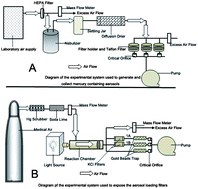A laboratory reactor system was developed to examine the role of light and aerosol composition in the reduction of oxidized mercury (Hg(II)) in laboratory-generated aerosols. Aerosolized sodium chloride, doped with mercury chloride, was exposed to light in a fixed-bed flow-through reactor. Three spectral ranges (UV, visible and a simulated solar spectrum) were examined, along with dark experiments, to investigate the role of light conditions in mercury reduction. In addition, the role of iron in the aerosol matrix was examined. The effluent from the reactor was analyzed for Hg(0) as evidence of reduction of Hg(II) in the reactor. Significant reduction of Hg(II) (1.5–9.9%) was observed for all three light sources and the rate of mercury reduction was proportional to the light irradiance. The presence of iron in the aerosol matrix inhibited the reduction rate and the degree of inhibition was dependent on the chemical form of the iron in the aerosol. The observed reduction reactions may be important chemical processes in the atmosphere and could be incorporated in atmospheric transport models that are used to understand the fate of atmospheric mercury.

You have access to this article
 Please wait while we load your content...
Something went wrong. Try again?
Please wait while we load your content...
Something went wrong. Try again?


 Please wait while we load your content...
Please wait while we load your content...